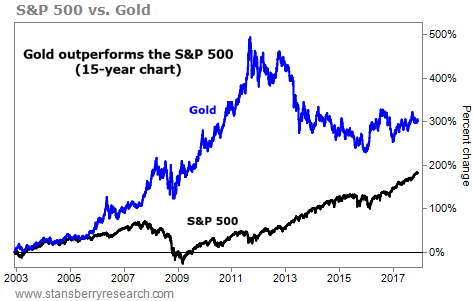The words get a lot of attention… But they’re almost never true.
They provoke greed and fear… And people’s emotions get the better of them.
Too often, they let themselves believe “this time is different.”
Over the past couple of days, we’ve talked about this phrase. It can lure you into making terrible decisions with your money… Or, on rare occasions, an idea behind the phrase can lead to gigantic returns. (That’s why it’s so tempting to believe.)
On Monday, we showed you that when history provides a big, testable data set, you’re usually better off betting that this time will not be different.
Then [on Tuesday], we touched on the pesky issue of timing. Sometimes, folks book thousands-of-percent returns before finding out if this time really is different.
Today, we’ll look at three current “this time is different” scenarios. Our goal isn’t to get to the bottom of each idea… Instead, we just need the appropriate investing or trading strategies for each situation.
As you’ll see, you don’t need to know if this time is different to make good decisions with your money…
Let’s start with the belief that…
1. This time is different with paper money.
Paper money has been used for more than 1,000 years. Usually, it’s printed and controlled by governments. And as those governments decide to spend more, they print more money… which erodes its purchasing power.
Every paper money that has ever existed has become valueless, except, of course, the ones we use today…
People believe that this time is different with the U.S. dollar, the euro, the Japanese yen, and other paper currencies… Or they haven’t thought about it. Why else would they hold 100% of their assets in these currencies, or in stocks and bonds that can only be exchanged for these currencies?
On this one, I’m comfortable saying this time will not be different. At some point, today’s paper currencies will become valueless, too. The only question is when.
And you don’t have to agree with me to make a good investment decision. If you think this time is different with paper currencies, you can hold the vast majority of your wealth in them. But you should still own some gold and silver…
Gold and silver are the only long-standing currencies that cannot be printed by governments. And they’ve been great investments, no matter your outlook for paper currencies…
October 9 was the 15-year anniversary of the bottom for the benchmark S&P 500 Index after the Internet bubble burst. Aside from late 2008 and early 2009, that bust was the best time to buy stocks in more than 20 years. But as you can see in the 15-year chart below, gold has performed better than stocks…
 I encourage you not to think about gold as an alternative to stocks, though. Think about it as an alternative form of savings… an alternative to the U.S. dollar.
I encourage you not to think about gold as an alternative to stocks, though. Think about it as an alternative form of savings… an alternative to the U.S. dollar.
Now, look back at the chart above. That horizontal black line at 0%… That is the U.S. dollar. Aside from other paper currencies, it’s challenging to find assets that perform worse over time.
No matter your thoughts on paper currencies, it makes sense to hold 5%-15% of your wealth in gold and silver.
We’ll move along quicker from here. Next is the belief that…
2. This time is different with cryptocurrencies.
People are going nuts for cryptocurrencies like bitcoin. They believe that this time is different… that a means of exchange not controlled by the government and large corporations can take hold.
They also believe this time is different in that an asset can soar thousands of percent, get lots of popular attention, and then soar hundreds or thousands of percent more… without a long, painful period of falling prices.
Bitcoin has soared nearly 66,300% over the past five years. It trades at around $8,200… And people are calling for it to rise to $50,000, $100,000, or even $1 million over the next decade or two (or less).
Cryptocurrencies and the related technologies are exciting. And many of them do have value.
The problem is, nobody has any clue how much value… especially because a lot of their future values will be based on whether people and governments adopt them.
In “this time is different” cases like this one, treat it like a speculation. You don’t need to – and maybe shouldn’t – avoid cryptocurrencies completely. But only invest what you’re willing to lose…
For most people, that would likely be in the range of 1%-2% of their wealth… and no more than 5%. (If 2% of your wealth soars 1,000%, it becomes a much more significant 18%.)
Finally, let’s consider the belief that…
3. This time is different with clean energy.
Big issues like climate change and sickening levels of pollution have lots of folks convinced that clean energies are the only way forward.
They believe that this time is different… that dirty sources of energy like coal and oil are on their way out for good… that solar, wind, hydro, nuclear, and to a lesser extent, natural gas will replace them.
Some believe that the internal combustion engine will disappear.
Just like with cryptocurrencies, if this time is different, investors will make huge amounts of money. They may even make fortunes if this time isn’t different.
So again, don’t avoid these investments. Just remember your asset allocation and position sizing. You don’t want to put too much of your wealth behind any one idea because you never know what the future holds.
In the end, this time is rarely different. But sometimes it is. As long as you keep things in perspective and practice smart money management, you’ll do just fine. And maybe you’ll do extraordinarily well.
Good trading,
Ben Morris
[ad#stansberry-ps]
Source: Daily Wealth


